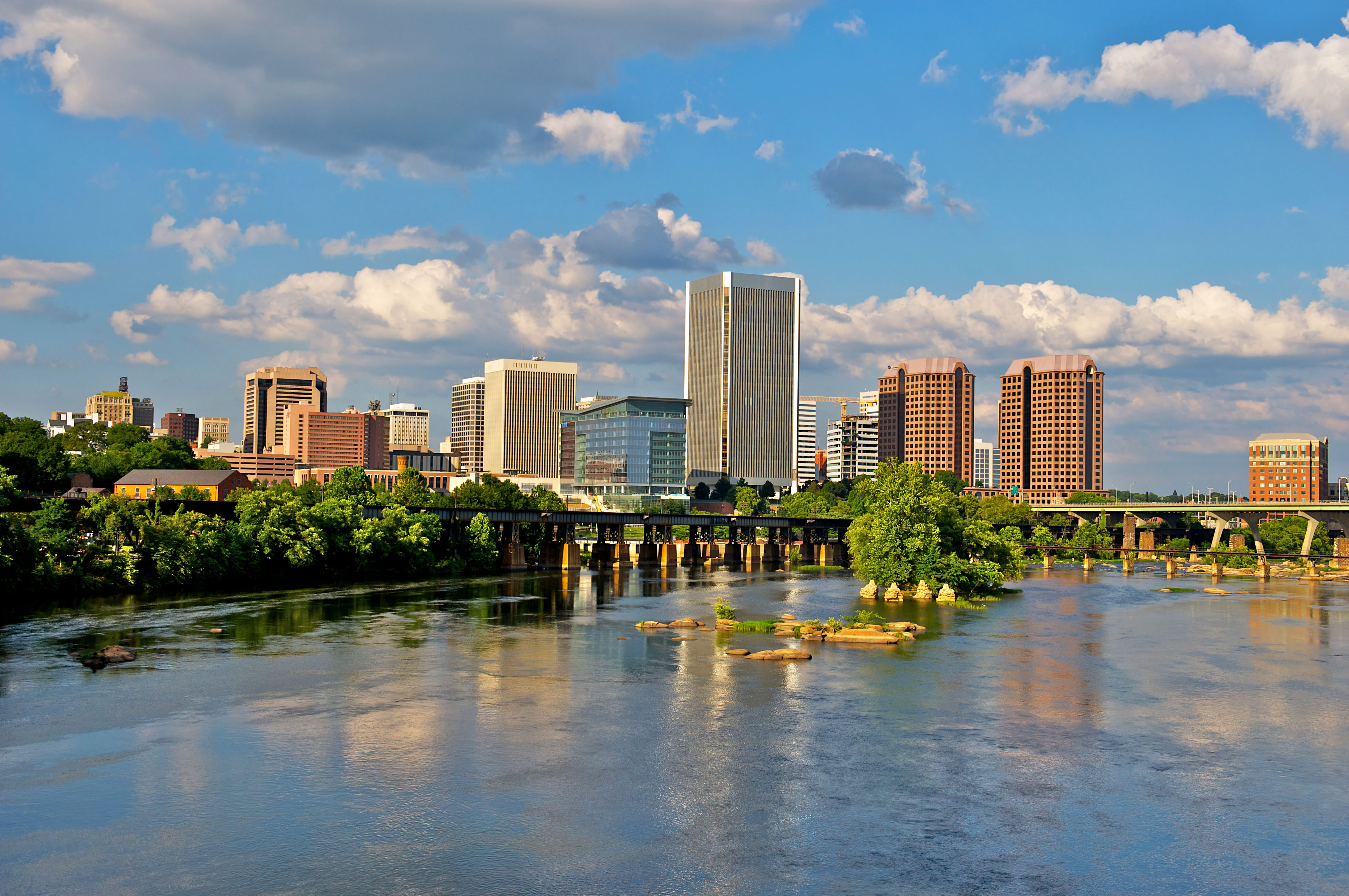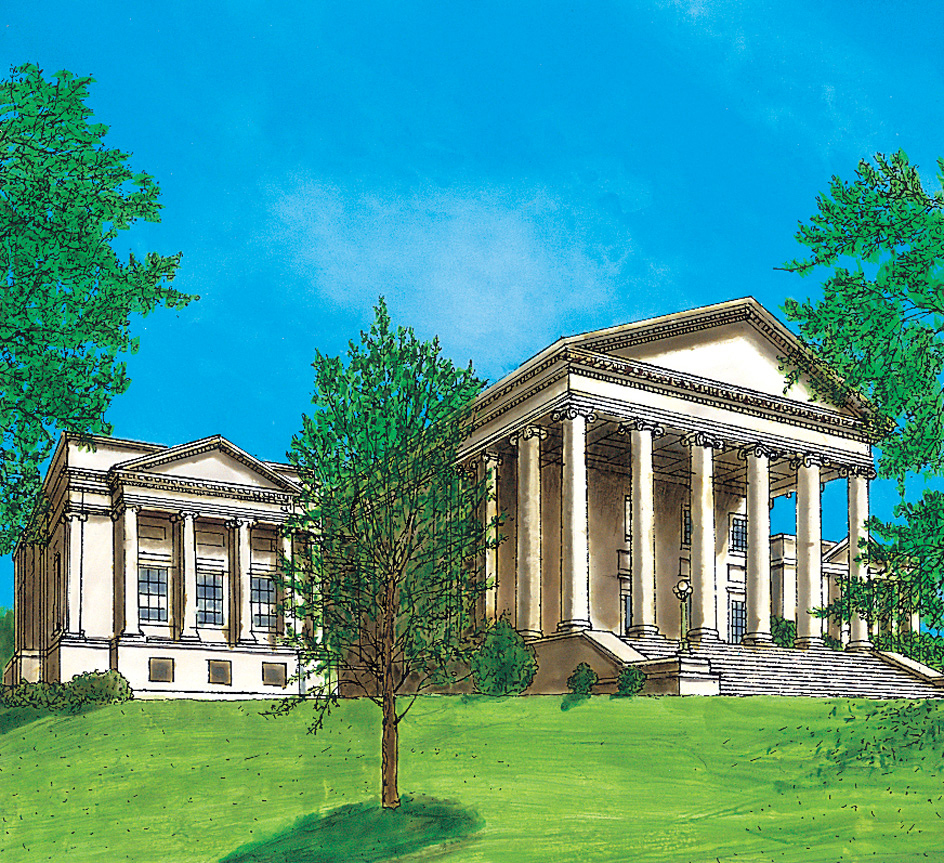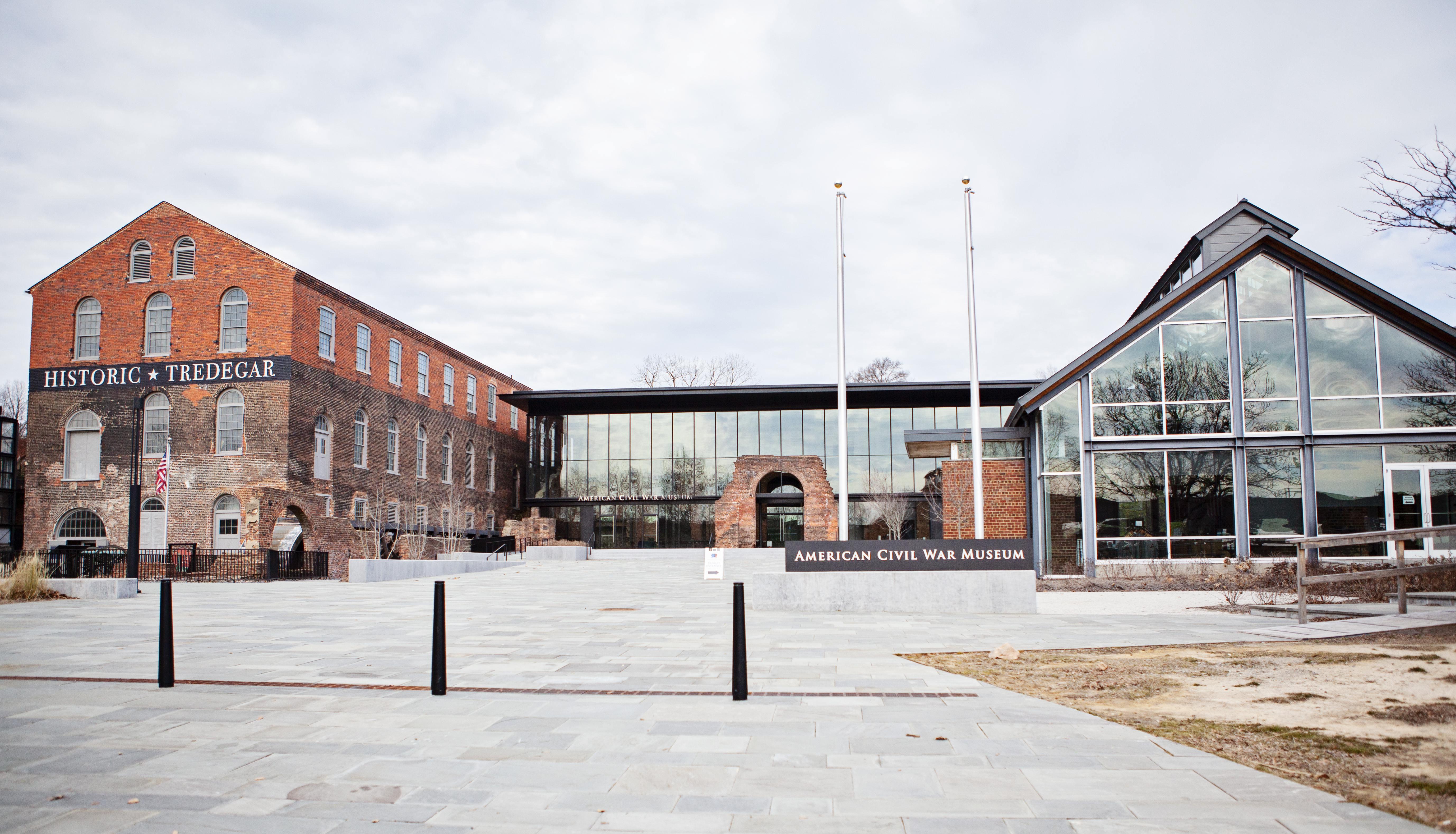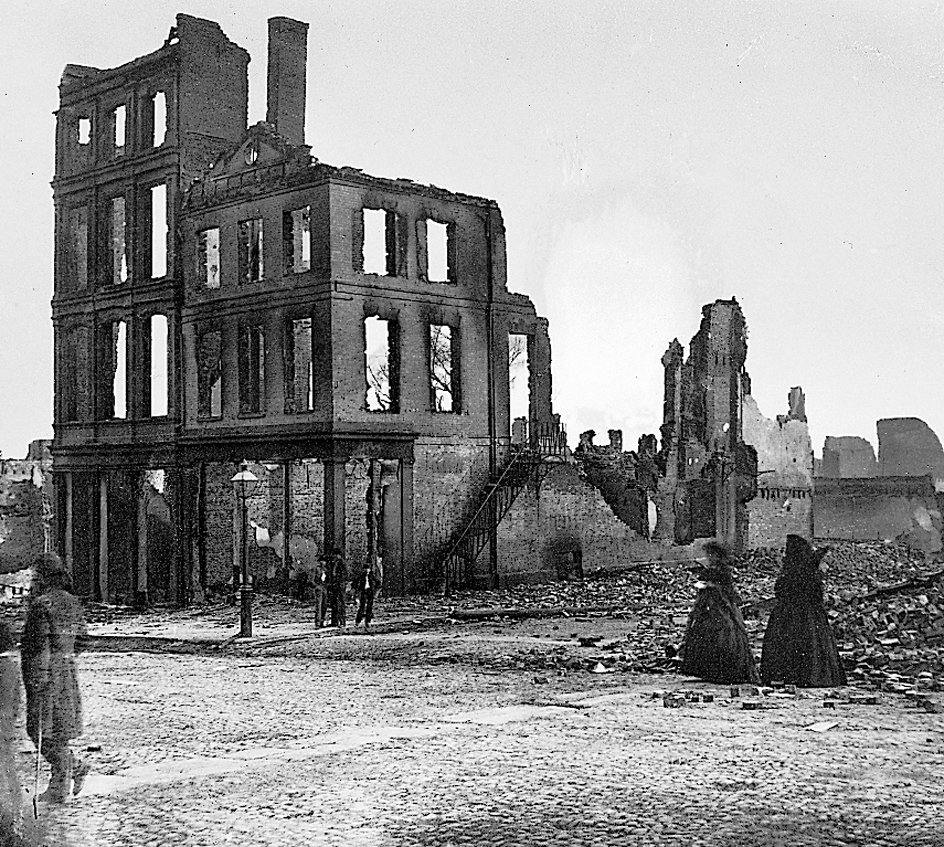Richmond (pop. 226,610; met. area pop. 1,314,434) is the capital of Virginia and a major commercial, cultural, educational, and historical center. It also ranks as one of Virginia’s largest cities. It was the capital of the Confederate States of America during most of the American Civil War (1861-1865).

Richmond lies on the James River, in east-central Virginia. In the mid-1600’s, English colonists chose the site because of its natural advantages for trade and transportation. Richmond was named for a suburb of London, England.
The city.
Richmond covers 60 square miles (155 square kilometers) on both sides of the James River. About half of the city’s people are African Americans. The Richmond metropolitan area covers 4,492 square miles (11,635 square kilometers).
A government area in downtown Richmond includes the city hall and a federal office building. The State Capitol stands in Capitol Square. Thomas Jefferson, before he became president, designed the building. Jefferson modeled it after a Roman temple in Nimes, France. The Capitol has influenced the architecture of many public buildings in the United States.
A famous marble statue of George Washington stands beneath the dome of the Capitol. The statue was completed in 1791 by the French sculptor Jean Antoine Houdon. Busts of seven other presidents who were born in Virginia are displayed in the encircling wall. The presidents are William Henry Harrison, Thomas Jefferson, James Madison, James Monroe, Zachary Taylor, John Tyler, and Woodrow Wilson.

A bronze statue of Washington on horseback stands in Capitol Square. Six bronze figures of important Virginia statesmen flank its stone base. Statues of Jefferson Davis, Stonewall Jackson, Robert E. Lee, Jeb Stuart, and other Confederate leaders once stood prominently along Richmond’s Monument Avenue. The Confederate statues were taken down in 2020 and 2021, however, following demonstrations protesting racial injustice and the lasting effects of slavery and white supremacy. A statue of the African American tennis star Arthur Ashe, who was born in Richmond, was added to Monument Avenue in 1996.

Education and cultural life.
A nine-member elected School Board supervises Richmond’s public school system. The Richmond area also has a number of private and parochial schools. Richmond is the home of the University of Richmond, Virginia Commonwealth University, and Virginia Union University. Virginia Commonwealth University includes the Medical College of Virginia. Also in the city is Union Presbyterian Seminary.

The Virginia Museum of Fine Arts owns a valuable collection of paintings, and Russian imperial jewels and jeweled Easter eggs designed by the Russian jeweler Peter Carl Faberge. The Science Museum of Virginia has science education exhibits and a planetarium theater. The Valentine history museum features exhibits that illustrate the history of Richmond. Exhibits at the Virginia Museum of History & Culture, the headquarters of the Virginia Historical Society, are displayed in a building known as Battle Abbey. The museum’s exhibits explore themes from throughout Virginia’s history. The Black History Museum and Cultural Center of Virginia, in the Leigh Street Armory, details centuries of African American life in Virginia. The Library of Virginia houses materials on early Virginia history.
The Richmond Symphony presents concerts at Richmond CenterStage, a performing arts center. Many popular music concerts and Broadway plays are held in the Altria Theater.
Other interesting places to visit
include:
St. John’s Church,
built in 1741. It is one of the oldest wooden buildings in the state. There, in 1775, the Virginia orator and statesman Patrick Henry delivered his famous speech that, according to tradition, ended with the words, “Give me liberty or give me death!”
American Civil War Museum,
which has exhibits that explain the perspectives of the Union, the Confederacy, and African American enslaved people and freedmen. It includes Historic Tredegar, a former ironworks; and the White House of the Confederacy, where Jefferson Davis lived as president of the Confederate States of America. The museum also maintains a third site, in Appomattox, near the site where Robert E. Lee surrendered to Ulysses S. Grant.

John Marshall House,
occupied by the fourth chief justice of the United States from about 1790 until his death in 1835.
Edgar Allan Poe Museum,
a group of buildings that form a shrine to the famous American author. Poe lived in Richmond as a child and later as editor of the Southern Literary Messenger, a magazine. One of the buildings, the Old Stone House, is believed to date from about 1737 and is probably Richmond’s oldest house.
Hollywood Cemetery,
the burial place of Confederate President Jefferson Davis and United States Presidents James Monroe and John Tyler.
Economy.
Many of Richmond’s people are employed by the local, state, and federal governments. Financial services are the largest private employers. These employers include banking, credit card, brokerage, and insurance companies. Manufacturing and trade and other service industries are also important to the economy. Richmond is the headquarters for a number of large companies. The city’s chief products include cigarettes, machinery for manufacturing and packaging tobacco products, chemicals, food products, and paper. Industrial research concerning tobacco and other products takes place in Richmond.
Airlines use nearby Richmond International Airport. Railroads provide freight service to Richmond, and passenger trains also serve the city. In addition, bus and truck lines connect Richmond with other cities. Oceangoing freighters use Richmond’s port on the James River. The Richmond Times-Dispatch, the city’s daily newspaper, ranks among the most influential newspapers in the South.
Government.
Richmond voters elect a mayor to a four-year term. The mayor must win a majority of the votes in five of the city’s nine districts. Voters also elect a representative from each district to serve on the city council. The council members serve four-year terms. The mayor, with council approval, hires a city administrator, who oversees the government’s day-to-day operations. The government of Richmond gets most of its revenue from real estate taxes and from state and federal sources.
History.
Before European settlers arrived, Native American tribes of the Powhatan Confederacy lived in what is now the Richmond area (see Powhatan). The city’s history began in 1607, when Captain Christopher Newport led an exploring party of English settlers to the site of what became Richmond. Two early attempts to establish a settlement there failed. The construction of Fort Charles at the site in 1644 attracted new settlers, and their community grew into a trading post for furs, hides, and tobacco.
In 1742, when Richmond was established as a town, it had a population of 250. In 1780, Virginia moved its capital from Williamsburg to Richmond, which had a more central location. Richmond had only 684 people at that time. It was incorporated as a city in 1782.
In 1781, during the American Revolution, British troops led by Benedict Arnold raided Richmond. Arnold was an American general who turned traitor and joined the British. His soldiers looted Richmond and burned several important buildings.
After the war ended in 1783, Richmond entered a period of growth. Its population increased to 3,761 by 1790 and reached 5,737 by 1800. The city developed around the tobacco trade, the trade in enslaved people, and trade to the west over the James River Canal. With the coming of the railroads in the mid-1800’s, Richmond grew rapidly as a commercial and industrial center. By 1860, it had a population of about 38,000. From the 1830’s until the start of the Civil War in 1861, Richmond was one of the largest slave markets in the United States. Traders in the city bought and sold thousands of enslaved people each year.
In May 1861, a month after the outbreak of the Civil War, Richmond replaced Montgomery, Alabama, as the capital of the Confederacy. The capture of Richmond became a prime goal of the Union forces, especially during the campaigns of 1862 and 1864. In April 1865, the Confederate government moved from Richmond to Danville, Virginia. Richmond’s people burned part of their city so it would not fall undamaged to the Union. The task of rebuilding the city began immediately after the end of the Civil War.

During the early 1900’s, the city attracted many industries. By 1950, it had a population of 230,310. In 1970, Richmond annexed 23 square miles (60 square kilometers) from neighboring Chesterfield County. A civil rights leader sued the city. He charged that the primarily white population of the annexed area would injure the rights of Richmond’s Black voters. A federal court approved the annexation in 1976. The city was divided into nine districts, each of which elects one member to the city council.
In 1977, African Americans won races for five of the nine seats on the city council. The council then elected Richmond’s first African American mayor, Henry L. Marsh III. Marsh served as mayor until 1982.
Richmond completed several major construction projects during the late 1900’s. The projects included a downtown canal walk, three major hotels, and a flood-wall along the James River. In 2003, a new convention center opened.
Also in 2003, Richmond voters approved a plan to have the mayor directly elected by the city’s voters instead of by the members of the city council. The change was approved by Virginia’s General Assembly the following year and became effective in the November 2004 election. In that election, Richmond voters chose L. Douglas Wilder to be mayor. Wilder served as mayor from 2005 to 2009. He had previously served as governor of Virginia from 1990 to 1994 and was the first African American to be elected governor of a U.S. state.
